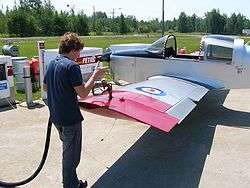Trailing edge
The trailing edge of an aerodynamic surface such as a wing is its rear edge, where the airflow separated by the leading edge meets.[1] Essential flight control surfaces are attached here to control the direction of the departing air flow, and exert a controlling force on the aircraft. Such control surfaces include ailerons on the wings for roll control, elevators on the tailplane controlling pitch, and the rudder on the fin controlling yaw. Elevators and ailerons may be combined as elevons on tailless aircraft.


The shape of the trailing edge is of prime importance in the aerodynamic function of any aerodynamic surface. George Batchelor has written about:
- “ ... the remarkable controlling influence exerted by the sharp trailing edge of an aerofoil on the circulation.”[2]
Other sharp-edged surfaces that are attached to the trailing edges of wings or control surfaces include:
- On control surfaces:
- trim tabs
- servo tabs
- anti-servo tabs
- Other surfaces:
- flaps
Other equipment that may be attached to the trailing edges of wings include:
- anti-shock bodies
- static dischargers
References
- Crane, Dale: Dictionary of Aeronautical Terms, third edition, page 521. Aviation Supplies & Academics, 1997. ISBN 1-56027-287-2
- Batchelor, G. K. (1967), An Introduction to Fluid Dynamics, p.438, Cambridge University Press.